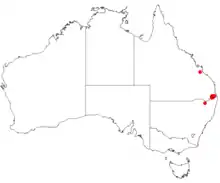| Acacia acrionastes | |
|---|---|
| Scientific classification | |
| Kingdom: | Plantae |
| Clade: | Tracheophytes |
| Clade: | Angiosperms |
| Clade: | Eudicots |
| Clade: | Rosids |
| Order: | Fabales |
| Family: | Fabaceae |
| Subfamily: | Caesalpinioideae |
| Clade: | Mimosoid clade |
| Genus: | Acacia |
| Species: | A. acrionastes |
| Binomial name | |
| Acacia acrionastes | |
 | |
| Occurrence data from AVH | |
Acacia acrionastes is a shrub belonging to the genus Acacia and the subgenus Phyllodineae that is native to parts of eastern Australia.
The shrub or tree has a spindly habit and typically grows to a height of 1.5 to 8 m (4 ft 11 in to 26 ft 3 in) and has smooth bark. It has linear phyllodes that are straight to slightly curved with a length of 6 to 17 cm (2.4 to 6.7 in) and a width of 2 to 4 mm (0.079 to 0.157 in). It blooms between July and August and produces inflorescences with creamy yellow flowers.[1]
The species was first formally described by the botanist Leslie Pedley in 1990 in the article Acacia acrionastes (Leguminosae: Mimosoideae), a new species from south-eastern Queensland as published in the journal Austrobaileya. The only synonym is Racosperma acrionastes. It is also often confused with Acacia adunca[2] to which it is closely related.[1]
It is found in north western New South Wales where it is considered rare and Queensland where it is more common. It is often a part of dry sclerophyll forest communities and grows in loamy clay soils over volcanic substrate.[1]
See also
References
- 1 2 3 "Acacia acrionastes Pedley". PlantNet. Royal Botanic Garden, Sydney. Retrieved 28 February 2019.
- ↑ "Acacia acrionastes Pedley". Atlas of Living Australia. Global Biodiversity Information Facility. Archived from the original on 28 February 2019. Retrieved 28 February 2019.